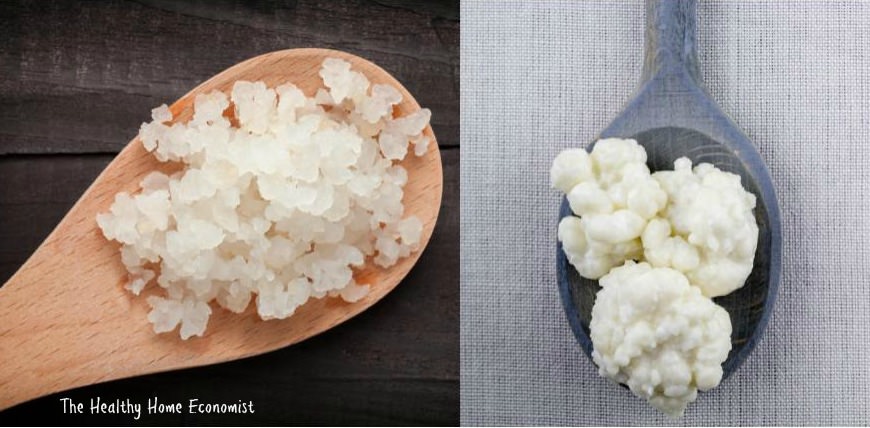Table of Contents[Hide][Show]

There are two ways to make kefir. First, you can make homemade milk kefir from dairy milk. You can also use the same type of culture to make coconut milk kefir at home.
The other type of live kefir culture is used to make water kefir and kefir sodas.
Unfortunately, folks new to traditional cooking sometimes get live water kefir and milk kefir grains confused. They might even attempt to use a milk kefir culture to make water kefir and vice versa. Not only do the live grains look and behave differently, but the beneficial microbes they impart to the fermented food or drink are quite different as well. For example, milk grains ferment in about 24 hours. A water kefir culture takes at least 2 and sometimes up to 5 days until the beverage is ready to drink.
No surprise when the fermentation doesn’t take or mold on the cultured food occurs with this type of mix-up. If you got some live grains from a friend and they didn’t seem to work very well, there is a chance that you might be using the wrong type of culture. If you aren’t sure, you can always buy instead.
Live grains for water kefir are available here and live grains for milk kefir are available here.
The Best Kefir
Note that live kefir grains are better than powdered starter. The dried powder contains less than 10 beneficial strains and no beneficial yeasts. The same goes for commercial kefir, by the way!
Live kefir grains, on the other hand, contain dozens of strains as well as beneficial yeasts to fight candida overgrowth.
In the video below, I show you the two types of kefir grains so that you know visually how to identify one versus the other.
Do you know the difference between milk kefir grains and water kefir grains? See the video below for clues!








I have milk kefir grains that look like little separates balls (they are not water kefir grains) when I put them in milk in the fridge until the next use it becomes like balls in clumps with cottage cheese around it. Do in put this into milk to get my next kefir milk? If I wash them out they are the balls again. My friend gave me legit grains but if I rinse it out there are no balls in there it’s basically coated cheese. Does that work to make kefir milk? Thanks so much!!
I’m new to making kefir and I can’t seem to figure it out. I put the grains in milk and waited 24 hrs, strained, repeated. I was throwing the strained stuff away for a few days cause my kefir stared dry. Now I have tons of white fluffy curds but my milk never gets thick. It will smell yeasty. If I strain it after one day it’s thin, no consistency change. Doesn’t taste good. I left it for an additional day, then I have the whole jar separating into curds and whey, clear yellow liquid. Still smells yeasty. Am I doing something wrong? How come I can’t get it thick and why does it taste so strong?
I started my milk kefir a couple days ago. It doesn’t look at all like cauliflower. It looks more like a big blob. Is something wrong? The milk looks more like curdled milk after about 24 hours. It doesn’t smell or taste like it though.
The kefir grains look like cauliflower, not the milk kefir itself which should resemble drinkable style yogurt.
Hello Sarah:
My grains look like it’s a farina type consistency. Also, one day, I wil put in a little bit of grains and the next day, my grains had quadrupled in the amount. My grains were till tiny, but the amount was huge. Is that normal and why are my grains not getting bigger?